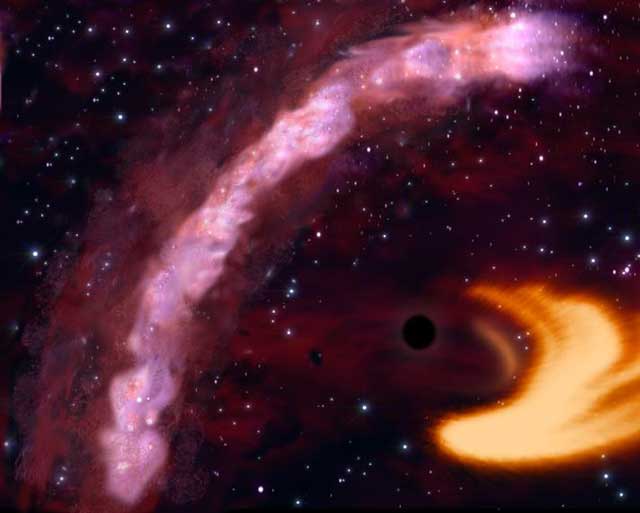Black Hole Rips Apart Screaming Star

In a distant galaxy, a star orbiting a massive central black hole strays too close to the insatiable giant and is torn apart. But before it can be devoured, the star lets out one last scream in a flare of light that slowly echoes across the galaxy. Astronomers on Earth pick up this faint call and use it to map the nucleus of the galaxy from which it emanated.
This scenario is no bit of science fiction — a team of astronomers discovered one of these rare and dramatic events while combing through the Sloan Digital Sky Survey last December. Their observations are detailed in the May issue of Astrophysical Journal Letters.
The team is still monitoring the "light echo," and for the first time, one of these events can be observed in great detail, allowing astronomers "to probe different regions of the galaxy," said study leader Stefanie Komossa of the Max Planck Institute for extraterrestrial Physics.
Campfire physics
The light echo currently coursing through galaxy SDSSJ0952+2143 likely originated as in the scenario above, with the following details: One of the stars orbiting the galaxy's central black hole likely strayed off course (perhaps after being nudged into "a fatal orbit," as Komossa called it, after interacting with another star). Eventually the pull of the black hole would rip the star apart, but before the stellar material was pulled into the accretion disk, it emitted a burst of high-energy radiation.
Komossa likens the sudden emission of light to throwing tinder into the smoldering embers of a campfire.
"Imagine a campfire which is almost extinguished so there is not much light around, and so you cannot recognize your surroundings. In a sense, that is like the core of a normal galaxy," she told SPACE.com.
Get the Space.com Newsletter
Breaking space news, the latest updates on rocket launches, skywatching events and more!
"If you throw some pieces of wood into the fire, it will shortly lighten up, and you can see the environment clearly. And sort of in the same way, in this galaxy, we observed a star was thrown into the black hole, like the piece of wood into the fire," Komossa added.
Just as the campfire would illuminate the people sitting around it and the trees in the background, this burst of radiation illuminates the regions of the galaxy as it hits them, only the immensity of the galaxy creates a time-delay effect.
"The dimensions of a galaxy are much bigger, so the light needs a lot of time to travel through the core of the galaxy," Komossa explained. "And whenever [the light] reaches a certain region, the gas [in that region] will temporarily shine up brightly and then will fade away again."
Time delay
Galactic nuclei are normally hard to resolve because a permanent accretion disk of dust and gas around the black hole illuminates everything simultaneously.
"But this light echo effect makes different components shine up temporarily, but … at different times. That is an exciting way to do some mapping of the components of the nucleus," Komossa said.
Different parts of the galaxy, such as the molecular torus (a swirling structure of gas and dust that shrouds the black hole and its accretion disk), have a "fingerprint" of atoms in their gases, and by examining the strong change the light echo creates in these fingerprints, the astronomers can tell what part of the galaxy the echo is traveling through. Then by timing how long it takes the echo to traverse the region, the scientists can estimate its dimensions.
The light echo that Komossa and her team are tracking is thought to have started in 2004, when the telescope of Sloan Digital Sky Survey routinely imaged and took spectral readings of the radiation in this and thousands of other galaxies.
Join our Space Forums to keep talking space on the latest missions, night sky and more! And if you have a news tip, correction or comment, let us know at: community@space.com.

Andrea Thompson is an associate editor at Scientific American, where she covers sustainability, energy and the environment. Prior to that, she was a senior writer covering climate science at Climate Central and a reporter and editor at Live Science, where she primarily covered Earth science and the environment. She holds a graduate degree in science health and environmental reporting from New York University, as well as a bachelor of science and and masters of science in atmospheric chemistry from the Georgia Institute of Technology.









